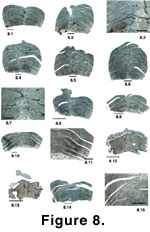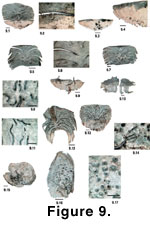 Description
DescriptionSardinops sagax (Pacific
Sardine)
(Other common names: Pilchard)
Figure 7.13
 Description
DescriptionLength: up to 36 cm but usually less than 27 cm.
Mouth: moderate, terminal, directed slightly upwards; when jaws closed, the lower is contained within the upper; upper jaw extends to point below pupil; teeth absent.
Body: seven downward radiating striae on the operculum; scale-like appendages below midlateral region at the base of the caudal fin; fleshy appendage at the point of pelvic fin insertion.
Color: dark blue or green on dorsal surface that shades to silver on lateral and ventral sides; black spots on the sides of the body under the scales.
Depth: pelagic schooling species (may also form schools with anchovy, hake, and mackerels).
Habitat: young fish will school in sandy shallow beach areas; as they mature they move into deeper coastal waters and migrate north.
Season: main spawning location is California with only sporadic occurrences in the northern waters; spawning is temperature influenced, and peaks in California in the spring (April-May).
Diet: zooplankton.
Predators: larger fish, marine mammals, sea birds.
Distribution: eastern Pacific: South America (Chile, Peru) to Gulf of California and Baja, to Alaska.
 Scale
Description
Scale
DescriptionRelative Scale Size: large.
Position of Scales on Body: 52-60 rows along midline of body; mid-ventral line has weakly keeled scutes (Hart, 1973).
Overall Scale Shape: circular to oval, the largest scales are squared. The posterior field is straight to gently convex. The outside edge of the posterior field is crenulated and curved. The overall shape of the posterior field can be highly variable depending on the scale type. The outside edges of the scales are smooth but can be irregularly shaped. These scales are generally more massive than Clupea and less flexible. In addition, many of the larger scales have protuberances in the central portion.
Focus and Circuli: the focus varies from indistinct to very distinct. It is often situated just above the posterior field interface and is generally central between the lateral fields, although it is sometimes slightly offset. The circuli are straight to curved, but generally concentric with the outline of the scale. Annuli seem to be more difficult to distinguish than in Clupea. The circuli are variable within a single scale with some being continuous between fields and others being discontinuous. The circuli tend to be more tightly compacted than in Clupea, but this is feature is plastic. In regenerated scales the circuli and focal area are quite distorted. Circuli generally end before the posterior field although a reticulation pattern may be present.
Radii: there are no radii present, however, some of the large square scales do have distinct fracture lines (looking similar to radii) in the lateral fields. These lines begin being parallel to the circuli then are directed away from the wing join and intersect circuli.
 Scale
Preservation
Scale
PreservationClupeid scales are, comparative to other fish
species, thick and robust and therefore preserve easily in Quaternary/Holocene
sediments.  Our
experience indicates that because of their robustness, sardine scales tend to
preserve whole, sometimes even with the posterior field (wing) attached.
That generality aside, Clupea scales tend
to rip and break at fracture areas. This characteristic results in few Clupea
scales, unless they are very recent, being found intact in sediments. The
leading edges of the anterior field and the wing clips are also often detached.
As a result it can often be quite difficult to distinguish Clupea
and Sardinops fragments. However, Clupea
scales (including the wings) are generally white and quite mechanically
flexible, and to some extent easily ripped, while Sardinops scales are often
amber and brittle.
Our
experience indicates that because of their robustness, sardine scales tend to
preserve whole, sometimes even with the posterior field (wing) attached.
That generality aside, Clupea scales tend
to rip and break at fracture areas. This characteristic results in few Clupea
scales, unless they are very recent, being found intact in sediments. The
leading edges of the anterior field and the wing clips are also often detached.
As a result it can often be quite difficult to distinguish Clupea
and Sardinops fragments. However, Clupea
scales (including the wings) are generally white and quite mechanically
flexible, and to some extent easily ripped, while Sardinops scales are often
amber and brittle.